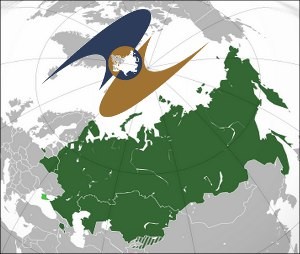BISHKEK (TCA) — Back in 2014, then minister of economic affairs of Kazakhstan Kairat Kelimbetov stated at the Astana Economic Forum that the Eurasian Economic Union (EEU) in the course of its formation “is learning a lot from the European Union – not just from the latter’s successes, but also from its mistakes”. Today, that statement is being put to the test – especially concerning the admission of Kyrgyzstan and Armenia by the bloc’s three founding members: Russia, Belarus and Kazakhstan.
Should the Eurasian Economic Union, now hardly more than one year old, consolidate first before looking for expansion, or expand first before consolidating?
The odds appear in favour of the former option – since states will only gladly join the Union if it has enough to offer and staying out will put them on the losing end. On the other side, the EEU as it exists will have to think twice before admitting “weaklings” and “troublemakers” if it wants to preserve and strengthen its principle of consensus.
Kyrgyzstan’s reasons for joining the bandwagon, besides the political motivations, look pretty clear: access to the EEU’s financial support mechanisms for its meagre state budget, an export market for its isolated production sectors and consolation for its half-million strong migrant workers’ community in Russia. For Armenia, motivations to jump along were quite different. The country is surrounded by neighboring states relations with which vary from lukewarm to openly hostile. Armenia is still officially at war with Azerbaijan and has occupied one-sixth of Azeri territory. A more than 20 year-old ceasefire is regularly violated. Baku has let it known that as long as this situation continues there is no chance of Azerbaijan joining the EEU.
The remaining former Soviet republics’ positions vary from reservations to open hostility. The first category includes Uzbekistan and Turkmenistan, and the second Georgia and Ukraine. Only Tajikistan has applied for membership, but the five existing members do not seem to be in a great hurry to admit it. Already with the entry of Armenia and Kyrgyzstan, public opinion, especially in Russia and Belarus, tended to frown on the move, fearing that the fledgling EEU would have another Ireland and another Greece on its hands. Tajikistan, which is in an even worse position both politically and financially, would be a burden hard to carry by the Union, already struggling with slumps in commodity prices on which most of their external earnings to major extents depend.
The idea of forming a Eurasian union originally came from Kazakhstan’s President Nursultan Nazarbayev, who publicly advocated it on numerous occasions ever since the mid-1990s. The deal, 20 years in the making, was “a hard-won achievement”, the Kazakh head of state was quoted by the Kazakh state news agency Kazinform at the end of 2014 as saying – adding that the signed document “…covers all the basic aspects inherent in international organizations, enshrines the principles of sovereign equality, territorial integrity, and respect for the particularities of the political systems of the members of the union. The important point is that decision-making at all levels of the organization is based on the principle of consensus.”
It looks almost idyllic. Since January 1 last year, there is only one border between the European Union and Kyrgyzstan: the one between Poland and Belarus. From there on, there are no traffic or trade barriers between the two, thanks to the establishment of the Eurasian Economic Union which eliminates all internal borders between Belarus, the Russian Federation, Kazakhstan, Kyrgyzstan and Armenia. It will save lots of time and agony to their inhabitants but also to European travelers and traders in terms of cross-border formalities, each of which could easily take hours for ordinary people and days for freight carriers. Moreover, investors within the domain have free access to a market of global size.
“The Eurasian Economic Union has an integrated single market of 176 million people and a gross domestic product of over 4 trillion U.S. dollar,” in the organization’s official documentation’s words. “The EEU introduces the free movement of goods, capital, services and people and provides for common transport, agriculture and energy policies, with provisions for a single currency and greater integration in the future. The union operates through supranational and intergovernmental institutions and is thus considered to be a congregatio adumbrata.”
Today regarding the EEU, it looks very much as though consolidation is a much better option than expansion in terms of priorities for the new bloc in its present form and size. Negotiations on mutual trade and investment partnerships with the People’s Republic of China, India, Egypt and Vietnam are underway. Once these treaties and preferably a few more are in place, they will add clout to the EEU. Concerning a common currency, though mentioned among the Union’s official goals, there is no consensus among its members even as their respective national currencies are getting more and more pegged to the Russian rouble. The most important lesson for the EEU is to link consensus to equal responsibility.

